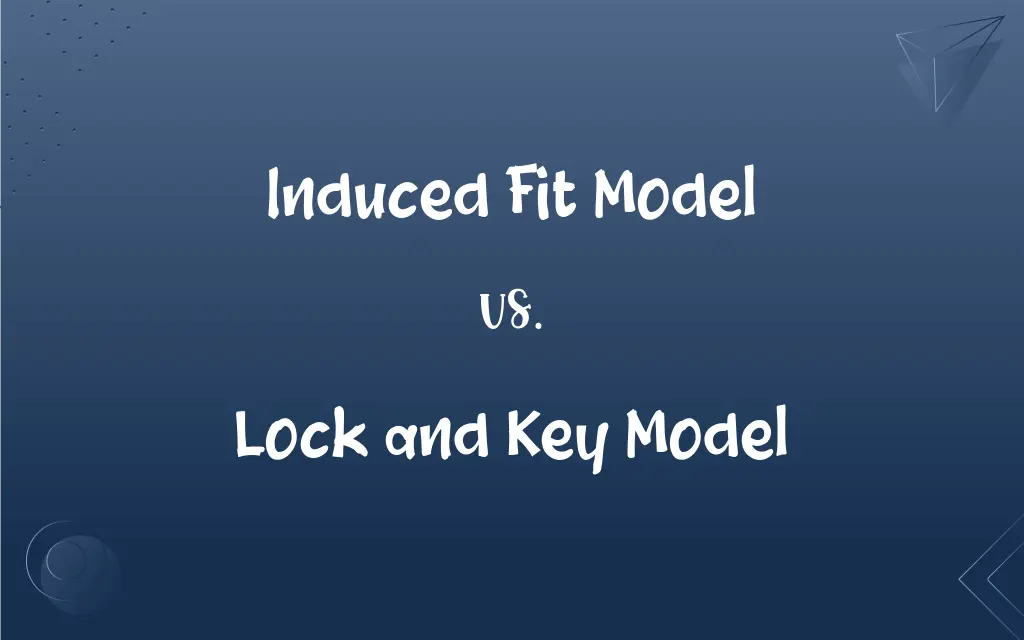Induced Fit Model vs. Lock and Key Model: What's the Difference?
Edited by Aimie Carlson || By Harlon Moss || Published on June 29, 2024
In Induced fit model enzyme changes shape for substrate binding. In Lock and key model enzyme and substrate perfectly match without shape change.

Key Differences
The induced fit model and the lock and key model are two theories explaining how enzymes interact with substrates to catalyze biochemical reactions. The lock and key model, proposed by Emil Fischer in 1894, suggests that enzymes and substrates are exactly complementary in shape, much like a lock and its key. Conversely, the induced fit model, introduced by Daniel Koshland in 1958, proposes that the binding of the substrate induces a change in the enzyme's shape, leading to a complementary fit. This model suggests that the enzyme's active site is somewhat flexible and can adjust to fit the substrate upon interaction.
The lock and key model emphasizes structural specificity and the static nature of enzyme-substrate interactions, the induced fit model focuses on the flexibility and dynamic adjustments between enzymes and substrates. The induced fit model better explains the catalytic efficiency and specificity of enzymes in biological systems, incorporating the concept of conformational changes upon substrate binding.
Both models serve to illustrate the fundamental concepts of enzyme action, with the induced fit model expanding upon the lock and key theory to accommodate observations of enzyme behavior that the earlier model could not explain. Understanding these models is crucial for studying enzyme kinetics, drug design, and the molecular basis of diseases and their treatments.
The distinction between the two models highlights the evolution of our understanding of biochemical processes. The lock and key model laid the groundwork for enzyme specificity, while the induced fit model provided a more nuanced view of how enzymes adapt to facilitate reactions, reflecting the complexity of biological systems.
Comparison Chart
Concept
Enzyme shape changes to fit substrate.
Enzyme and substrate perfectly match.
ADVERTISEMENT
Enzyme Flexibility
Dynamic, adjusts shape for substrate.
Static, no shape change upon binding.
Substrate Specificity
Broad, accommodates similar substrates.
Narrow, requires exact complementarity.
Explanation of Catalysis
Emphasizes conformational changes.
Focuses on structural specificity.
Historical Context
Proposed later to address limitations.
Earlier model, foundational concept.
Induced Fit Model and Lock and Key Model Definitions
Induced Fit Model
A model where enzymes change shape to bind substrates.
The induced fit model explains how enzymes can adapt to different substrates.
ADVERTISEMENT
Lock and Key Model
Suggests no change in enzyme shape upon substrate binding.
In this model, substrate binding does not alter the enzyme's structure.
Induced Fit Model
Allows for a broader range of substrate specificity.
Enzymes can catalyze reactions with similar substrates through induced fit.
Lock and Key Model
A model proposing enzymes and substrates as perfect matches.
The lock and key model likens enzyme specificity to a lock and its key.
Induced Fit Model
Accounts for conformational changes upon binding.
According to the induced fit model, enzymes wrap around substrates for a tighter fit.
Lock and Key Model
Emphasizes the specificity of enzyme-substrate interactions.
This model explains why certain enzymes only work with specific substrates.
Induced Fit Model
Reflects the dynamic nature of enzyme activity.
The induced fit model highlights how enzymes actively participate in catalysis.
Lock and Key Model
Represents the foundational concept of enzyme action.
The lock and key model provided the first explanation of enzyme specificity.
Induced Fit Model
Emphasizes enzyme flexibility during catalysis.
This model shows enzyme's active sites are not rigid but adaptable.
Lock and Key Model
Highlights the importance of structural complementarity.
Exact fit between enzyme and substrate is crucial in the lock and key model.
FAQs
Why was the induced fit model proposed?
To address observations that the lock and key model couldn't explain.
Which model suggests enzymes can bind multiple substrates?
The induced fit model, due to its flexibility.
How do the models differ in enzyme flexibility?
Induced fit allows shape change; lock and key does not.
Can the lock and key model explain all enzyme activities?
No, it fails to account for the dynamic nature of some enzyme-substrate interactions.
How does substrate specificity differ between the models?
Induced fit allows broader specificity; lock and key requires exact matches.
Can an enzyme follow both models?
Some enzymes exhibit behavior explained by both models, depending on the reaction.
What is the induced fit model?
A theory that enzymes change shape to bind substrates.
What is the lock and key model?
A theory that enzymes and substrates match perfectly without shape change.
Which model is more accepted today?
The induced fit model, for its comprehensive explanation of enzyme action.
What impact do these models have on biochemistry?
They are fundamental in studying enzyme kinetics and mechanisms.
Do these models affect how drugs are designed?
Yes, understanding enzyme flexibility is crucial in drug design.
How do these models relate to allosteric regulation?
The induced fit model is more aligned with the concept of allosteric changes affecting enzyme activity.
Why is enzyme flexibility important?
It allows enzymes to catalyze reactions more efficiently by adapting to substrates.
How do conformational changes affect enzyme activity?
They can enhance substrate binding and catalysis, as explained by the induced fit model.
What limitations does the lock and key model have?
It cannot explain the adaptability of enzymes to substrates of similar shapes.
What future research might these models inspire?
Further investigation into enzyme structure and dynamics, aiming to develop more effective drugs and understand disease mechanisms.
Are these models mutually exclusive?
While distinct, they can be considered complementary for understanding different aspects of enzyme function.
What does the lock and key model say about enzyme specificity?
It suggests enzymes are highly specific, acting only on substrates that fit perfectly.
How has our understanding of enzyme-substrate interaction evolved?
From the rigid lock and key to the more dynamic induced fit, reflecting advances in biochemical research.
How do the models influence enzyme kinetics studies?
They provide frameworks for understanding reaction rates and specificity.
About Author
Written by
Harlon MossHarlon is a seasoned quality moderator and accomplished content writer for Difference Wiki. An alumnus of the prestigious University of California, he earned his degree in Computer Science. Leveraging his academic background, Harlon brings a meticulous and informed perspective to his work, ensuring content accuracy and excellence.
Edited by
Aimie CarlsonAimie Carlson, holding a master's degree in English literature, is a fervent English language enthusiast. She lends her writing talents to Difference Wiki, a prominent website that specializes in comparisons, offering readers insightful analyses that both captivate and inform.







































































